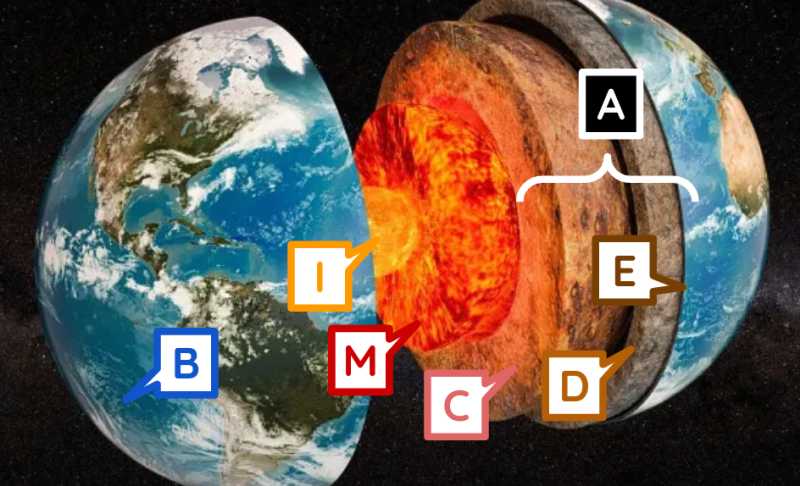The Formation of the Earth
Table of Contents
37. How the lower body C was divided into several others.
Gradually:
- body
Cbecame so hard that its particles could no longer connect tightly and nor be expelled from the motion of the air-aether. - the particles of body
Bwere so ordered that easy and equal pathways were provided for the surrounding air-aether on all sides.
Body D then began to be distinguished from body B and C.

I is the innter core, M is the outer core, C is the lower mantle, D is the upper mantle, E is the crust,Therefore, several particles of the earth-aether was expelled from body B towards C later.
These particles, if they were more solid than those composing body D, descending below them, joined body C, remaining either on its surface or penetrating below it.
Thus, this single body C was divided into several others. Some fluid escaped from it entirely, congregating particles in that region where their shapes hindered easy adherence to one another.
However, not all details can be explained here.
38. The formation of Body E above Body D
Particles less solid than those of body D fell down from B.
- These stuck to the surface of body
D
Many of them were branched, and so they gradually joined together forming the hard body E
- This body is very different from the two fluid bodies
BandD.
In the beginning, it was very thin, like a crust or bark covering the surface of body D.
But as time passed, it thickened, with new particles from body B attaching to it.
- Those from
Dalso attached to it because the rest of bodyDwere not completely similar.- And so they were expelled by the motion of the air-aether as I will soon explain.
These particles in body E were arranged differently because the Earth’s surface varied.
- On some parts, it was day or summer.
- On other parts, it was night or winter.
The different actions of light and heat on those parts caused them to be different.
- This created various layers superimposed on each other.
39. The growth of body E and the purification of body D.
It did not take long for:
- the upper region of the Earth,
A, to be divided into 2 bodies,BandC - many elongated oblong particles to be gathered towards
D - the first inner crust of body
Eto be formed.
Only after a space of several years could:
- the particles of body
Dbe reduced to the flexible and inflexible ones, and - all the crusts of body E could be formed.
At the beginning, there was no reason why the particles flowing towards D should not be slightly thicker and longer than each other, nor why they should be completely smooth and cylindrical, but could still have some roughness, although not enough to be branched.
According to their length, they could be flat or angular, thicker at one end than the other.
However, they did not stick together. This allowed the air-aether flowing continuously around them to move them.
Gradually through mutual friction, they became smooth and cylindrical, and equally thick and smooth along their length.
They passed through the same paths. The others succeeded in the places of others, which could not accommodate larger ones, nor be entirely filled by smaller ones.
But many of them could not be brought back to the common standard of others. These were gradually expelled from body D by the motion of the air-aether globes.
- Some of them joined body
C. - But most ascended towards
EandB, supplying material to bodyEby increasing it.